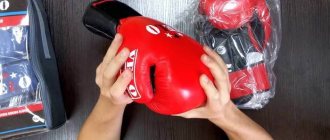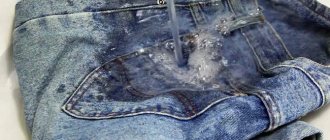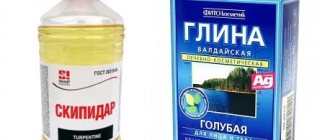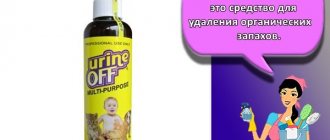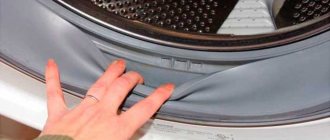For the manufacture of boxing gloves, natural leather or its artificial substitutes are usually used. The first option is considered the most preferable, since this material allows the skin to breathe. The disadvantage of such products is their high cost. Therefore, most often they buy options made of artificial leather.
For the production of sports equipment, the manual method is most often used. It is very difficult to establish continuous production of this equipment due to the large number of small parts.
The cut leather is stitched using strong lavsan threads, and then the product is filled with several layers of special synthetic filler.
The outer shock-absorbing layer, located on the impact surface, has a relatively low density. More dense materials are used for the interior upholstery, as it is designed to absorb shock.
Washing rules
It is advisable not to expose such items of boxing equipment as gloves to water at all. There are several objective reasons for this:
- When washed too harshly or after improper drying, natural leather becomes hard, and its artificial counterpart becomes cracked.
- Getting wet leads to the fact that the low-quality filler clumps together and the product finally becomes unusable, as it loses its shock-absorbing properties.
- Due to the dense padding, boxing mittens take several days to dry. During this time, bacteria accumulate and actively spread inside, which become a source of unpleasant odor and cause irritation on the skin.
How are boxing gloves made?
If the dirt is very strong and you cannot do without wet treatment, you need to wash the equipment very carefully, taking all precautions. The basic rules are as follows:
- To soak equipment, you can use water whose temperature does not exceed +40 degrees.
- The soaking time should be no more than four hours.
- When washing, you need to take all measures to prevent the inside of your equipment from getting wet.
- Dirt from the outside should be wiped off with a soft sponge, and to clean the equipment from the inside, use a soft brush.
- Difficult blood stains and heavy dirt should be wiped with a cotton pad soaked in hydrogen peroxide.
- The equipment must not be subjected to any kind of deformation.
- After each workout, you should wash your boxing bandages separately.
- If possible, do not machine wash.
ARTICLE FOR YOU
How to wash car covers: in a washing machine and by hand
Danger of getting wet
Boxing gloves are a multi-layer construction covered with genuine leather or its substitute. The inside of such equipment is stuffed with horsehair, cotton wool or polyurethane to soften impacts and protect the athlete's hands.
Getting completely wet is dangerous for this sports accessory due to its multi-layer structure and the nature of the materials. When wet, the filler may clump together and stop protecting the limbs upon impact, which can lead to injuries in the future.
In addition, this part of the equipment is difficult to dry. If moisture accumulates in the filler, mold fungi and pathogenic microorganisms will begin to develop in it, which cause an unpleasant musty odor and can damage the skin of the athlete’s hands.
Getting wet is no less dangerous for the surface of the equipment, since it deteriorates from moisture. The skin or its substitute becomes rougher, and instead of folds and bends, cracks appear on them.
During intense training, even minor damage turns into tears due to the load on the material, so it is not recommended to immerse this sports accessory in water.
Ways to get rid of unpleasant odor
Experienced athletes try to avoid washing their boxing gloves. Therefore, to eliminate the stench, all kinds of folk remedies are used. For example, freezing equipment in the freezer is considered a good way.
To do this, the product is wrapped in polyethylene and sent to freeze for 8 hours. This method completely destroys bacteria and therefore the smell also goes away. This treatment is very effective, but it should not be used very often, since negative temperatures damage the structure of the skin.
After freezing, the product is hung to dry for two days on a balcony or other well-ventilated place.
One way is freezing
Another treatment method is to use 6% table vinegar or apple cider vinegar. A cotton swab is moistened in this liquid and placed inside the product. After 2 hours, the cotton wool is removed, and the equipment is air-dried for several days so that the vinegar aroma disappears.
A good and convenient option is to treat the product with a special antibacterial spray. Such products are sold in specialized sports stores.
The spray has a special spout shape, so it is convenient to treat equipment from the outside and inside. Several procedures are required to completely eliminate the unpleasant odor.
It is very important to use an antibacterial spray
You can eliminate the stench from sweat and get rid of all bacteria by treating your equipment in a special sterilizer. A similar device is used to sterilize bottles and jars for baby food. For the same purpose, some use a microwave, setting it to minimum power.
Is water harmful?
In general, it is not recommended to wash gloves. Moreover, many generally consider any wet cleaning of such products unacceptable. But why are people afraid to throw this equipment into the washing machine or soak it in a basin?
First of all, washing can damage the outer material: if it is leatherette, there is a high probability that the surface will crack during drying or be damaged during aggressive washing, but if it is genuine leather, then it will most likely become deformed and lose its “marketable” appearance. Sometimes, after washing, gloves can “shrink,” which can also be a reason to throw them in the trash. As for the filler, whatever it is, washing or soaking can cause the material to pill, and no tennis ball thrown into the washing machine, as is the case with down jackets, will help here
If the filler does not straighten out after drying, the gloves will have to be thrown away, because they will no longer be able to perform the function of softening the impact. Well, the most important thing: they will take a very long time to dry after washing (from 3 to 7 days until completely dry), and if the drying is not done correctly, during this time a new army of bacteria will breed in them. Microorganisms love a dark, moist environment, so try to speed up the drying a little
We'll tell you exactly how this can be done a little later.
Does this mean that boxing gloves cannot be washed? Not really. Many athletes were able to spin them in the washing machine without much damage to the product.
Here are the methods that most people use.
Soaking in a bowl of warm, but not hot water and powder overnight
Be careful: prolonged soaking may cause leatherette to crack! Soak in warm salt water overnight. Let us remind you that leather products do not like moisture and can become deformed after such treatment. Machine washable at 30˚C without spin
You can wash both leatherette and leather in a machine, but washing at this temperature cannot kill bacteria, so it only helps get rid of a slight odor.
True, washing, even using proven methods, remains at your own peril and risk: it is quite possible that your gloves will not like cleaning with water and the product will be damaged.
Handwash
Many athletes argue that boxing gloves should not be wet cleaned at all. It is highly likely that exposure to water will lead to irreversible deformations of the outer coating and internal filler. After such cleaning, the equipment usually becomes unusable and has to be thrown away.
ARTICLE FOR YOU
How to wash bed linen without fading: in a washing machine and by hand, frequency of washing, is it worth washing new ones?
How to properly hand wash boxing gloves
If you cannot do without washing, it is recommended to soak the gloves in non-hot water, having first dissolved the washing gel in it. Do not overexpose the product in water to avoid damaging the leatherette.
Another method of wet cleaning is to soak the gloves in warm water with added salt. This method gets rid of dirt and odor, but can cause the natural leather to dry out and become wrinkled.
To refresh the appearance and remove dirt on the outside, it is recommended to wipe the gloves with damp wipes. After this, the surface must be covered with colorless shoe polish.
Can boxing gloves be washed?
It is not recommended to wash gloves made of leather or its artificial substitute. The material can not only deform, but also begin to crack and crumble. In addition, it is difficult to completely dry a dense layer of filler.
Products are made of several layers:
- The outer covering in most cases is made of a durable leather cover. Exposure to moisture has a negative effect on it.
- The middle layer consists of a special filler and is laid so that it retains the desired shape for a long time.
- The lower one is covered with natural fabric, which prevents the appearance of calluses.
Just a few drops of water that get into the pores and seams cause mold and rot. As a result, the internal structure of the protection is destroyed.
Despite this, there are several methods of “gentle” washing, in which the product can be preserved.
Machine washable
You should only put this piece of sports equipment into the washing machine as a last resort. In this case, it is necessary to pack each glove in a special washing bag to protect the top coating from damage from the inner surface of the drum. For the machine, you need to select the most gentle washing mode and set the water heating temperature to +30 degrees.
Machine washing is a last resort.
Spin must be turned off. After the cycle is completed, the water should simply be drained. Do not twist the product or squeeze it with your hands. The water should drain naturally. To speed up this process, you can knock your gloves together.
If you had to wash: rules
Most often, this decision comes when the item begins to emit a distinct odor of sweat (bandages reduce the risk of encountering such a side effect, but people sometimes forget to use them). You can’t avoid washing even after street battles. What to do? The likelihood of buying new gloves will decrease if you follow these simple rules:
- We wash only in water with a temperature close to body temperature and with a gentle gel;
- do not twist or wring out - just lightly press to the bottom of the basin;
- If you decide to machine wash, select the no-spin mode at minimum temperature and use a liquid detergent.
The main condition for washing without loss is the speed of all manipulations, eliminating prolonged contact with water.
Advice! Don't have any special detergents at hand? You can wash them with baby shampoo. Or “adult”, but without excess chemicals.
Drying
After washing, the equipment should be dried for several days. To speed up the process, gloves should be stuffed with old newspapers. They will help maintain their shape and absorb moisture.
The place for drying should be chosen in the shade so that the gloves are not exposed to sunlight. But there must be free access of air. You cannot place equipment on a radiator or near heating devices.
This can cause the top coating to crack or become deformed. When the gloves are completely dry, the leather covering should be lubricated with castor oil, colorless shoe polish or glycerin.
ARTICLE FOR YOU
How to wash a tie correctly: in the washing machine and by hand
How to dry gloves correctly
How to dry safely
It will take a very long time to dry gloves after wet cleaning. This will take from 2 to 4 days. During this process you should:
- Unfasten all Velcro and open the mittens wide. Make sure they remain in this position for as long as possible.
- Pack your equipment often and tightly with newspapers. The paper will absorb excess moisture to the maximum. At first you will have to change it every half hour, then less often.
- Use a dryer or radiator. Having stuffed the inside of the products with paper, they can be placed on a moderately warm heating device.
- Turn on the hairdryer periodically. The inner surface will dry faster if exposed to hot air. Just don’t get carried away, resort to this method when there is little water left inside and the material feels dry to the touch.
Tip: the interior upholstery can be cleaned periodically using a steam generator. The exposure should not be prolonged, and after it the gloves should be briefly stuffed with paper. It will absorb any remaining moisture from the steam.
Rules of care
To save yourself from washing and keep your equipment in working condition longer, you need to take care of your gloves. After each workout, you need to take it out of your sports bag and dry it thoroughly, stuffing it with paper towels or crumpled newspapers.
The paper will absorb all the sweat and prevent the growth of bacteria. For the same purpose, you can use a special electric shoe dryer.
Gloves should not be allowed to lie next to sweaty clothing. You need to carry equipment in a separate plastic bag or case. This will prevent bacteria from growing in the inner layer.
If after washing the equipment does not have time to dry completely before the next workout, you should never wear gloves. The mixture of moisture and sweat creates the most favorable environment for the development of harmful microorganisms. It would be better to purchase a second pair of gloves to replace them.
Sweat is a breeding ground for harmful bacteria
A good way to prevent the spread of harmful microorganisms is to use an antibacterial spray. It is useful to spray the inside of your gloves before each workout or apply it directly to the skin of your hands. In a similar way, you can use antiseptic pharmaceutical gel.
During each workout, you should bandage your hands with special bandages. They greatly simplify equipment care and wet cleaning, since they absorb all the sweat from the inside. Then the bandages must be washed.
Cleaning the bandages
To keep your gloves from getting wet as little as possible, it is recommended to use boxing wraps. They are wrapped around each hand before putting on the protective equipment, due to which the multilayer accessory becomes dirty more slowly. Washing boxing bandages can be much easier because they are made of fabric. It is advisable to clean them after each workout.
Because boxers' hands sweat a lot during physical activity, the fabric becomes saturated with secretions, and if it is reused without cleaning, the skin of the upper extremities stops breathing and sweating increases. There are a few things to consider when caring for your bandages:
- They can be washed either by hand or in a machine;
- when using the machine, you should choose a temperature of no more than 35 degrees and a delicate wash mode, otherwise the bandages may lose their shape;
- for cleaning it is better to use mild detergents;
- when machine washing, it is advisable to place the bandage in a special mesh so that it does not stretch;
- It is not recommended to iron this part of the equipment.
After cleansing, the bandages must be straightened and dried thoroughly. So that they have time to dry completely, it is better to have a spare pair. Drying is recommended to be done away from radiators and radiators, and also not under the influence of sunlight.
Chemical assistants
Maintaining your boxing gloves with professional products is a quick and effective method for removing odors. Similar products are sold in sports stores and some hardware stores.
Store-bought products are very effective in combating odor.
In practice, the following compositions have proven their effectiveness:
- Salamander. Long acting fungicide. Manufacturers recommend using it several hours before the fight, as the product takes a long time to be absorbed. Price – 260 rub. for 100 ml.
- Cliven. Use the cream locally, treating problem areas. For best effect, leave the composition for 5-6 hours. Price – 200 rub. for 100 ml.
- No stick. Boxers are already actively using dry disinfectant + sorbent in the form of pads in the care of their equipment. Costs 170 rubles.
- Collonil. Spray neutralizer for persistent strong odors. It acts quickly and is economical - a couple of sprays are enough for each mitten. Price – 370 rub. for 50 ml.
- Dufta. The universal hypoallergenic spray does not require drying (like many household chemicals), safety is guaranteed by plant enzymes and water from which the neutralizer is made. Treat gloves on both sides, wrap in polyethylene for 30–40 minutes. Odors of both organic and inorganic origin have never happened! The corresponding price is 570 rubles. for 100 ml.
How to machine wash, hand wash and dry clean
One of the main components of the process is choosing the appropriate product. It should be as gentle, caring and relatively safe for such capricious products. It is best to take preparations for delicate washing or cashmere that contain lanolin:
Machine wash rules
Proceed with washing in the washing machine as a last resort, because you cannot vouch for the quality of the material and the integrity of the manufacturer, who could replace a durable filler with a cheaper one.
- During the process, use a delicate, gentle wash as much as possible.
- The temperature should not exceed 30 degrees. The bacteria, of course, will not die, but you can get rid of the smell.
- Use liquid detergent. Choose with lanolin or for cashmere. The main thing is that it has the safest possible composition and has caring components.
- It is best to place each glove in a washing net before loading.
- You should not combine equipment with other things.
- Drying and spinning in a machine cannot be used.
- After washing, turn the gloves over with the opening facing down and allow the water to drain freely.
Manual rinsing and drying
Most athletes leave machine washing as a last resort, content with doing it manually. Get ready for the fact that you will not be able to completely wash the inside, but you will be able to somehow clean the product.
Instead of a full wash, many people prefer soaking. For gloves, it lasts no longer than three hours, the liquid temperature is room temperature. The process has two ways:
- Dissolve 50 g of powder in 10 liters of water,
- Mix 250 g of salt completely in one bucket of water. To achieve a high-quality result, things can be left in this solution overnight.
The sequence of actions during manual cleaning is as follows:
- The outside of the material is wiped with a soft cloth, and the inside with a similar brush.
- Rinsing must be repeated many times. In this case, you cannot rub or squeeze the product. If you have already wet the inner lining, then water is simply drawn into the glove and drained until it comes out clean.
- The mittens do not twist. They are turned over with the hole down and the water is knocked out by tapping them against each other.
Dry cleaning
In addition to the usual washing, there is also dry cleaning. She will help you out if:
- a short interval is expected between fights,
- when biological particles are visible from the outside and can be absorbed into the surface,
- you have plenty of time to dry and there is no need to rush it.
There are several cleaning methods:
The outer surface is wiped with a regular cloth. You can use just water, or it’s better to add a little soap and wash the trim with it. If you find any stains that cannot be removed by regular wiping, then treat them with hydrogen peroxide (moisten a cotton swab and rub)
Please note that the surface must remain dry after the procedure. Get a hairdryer involved. Remember that the minimum heating mode is acceptable (cold air is possible)
The nozzle is directed directly into the product. According to the technology, turn off the device every 5 minutes and check how dry the inside of the mitten is. Once you've finished with one glove, move on to the second. This method is good if you have several fights in a row.
Also on store shelves you can find more modern products specially produced for fabrics that cannot be washed:
- Spot Remover. Dry powder that quickly fights various contaminants. Can be used at any time in a convenient place.
- DRYEL. Incredibly easy to use dry cleaning kit. Gives things a pleasant smell.
- K2r is an aerosol stain remover. Suitable for any type of fabric. It acts quickly and easily dissolves stains.
In addition to all of the above, there are many folk and chemical remedies that will help you remove unpleasant odors, partially or completely disinfect the inside of the mittens, and at least prolong the service of your equipment for a short time.
Manually
The process is practically no different from the previous method:
- gloves must be soaked in warm, soapy water for several hours; it is not recommended to carry out this procedure for more than four hours;
- clean the outer part with the non-abrasive side of the sponge;
- The inside is cleaned using a soft brush;
- It is forbidden to twist them; the best option would be to let the water drain naturally or, to speed up the process, lightly squeeze several times.
This option is slightly better than the previous one, but due to the fact that a large amount of water is still used, also use it with caution.
Features of choosing a detergent
The main thing is not to use low-quality, cheap powders. It’s better to give up the powder altogether, because... Even if you choose an expensive brand, when washing, grains may become clogged in the filler or pores of the skin, and it will not be possible to rinse them properly.
A good option for washing would be:
- shampoo;
- fabric softener;
- mild detergent;
- cream-gel for delicate fabrics.
Using fabric softener will better remove third-party odors.
Drain hose
How to clean a drain hose that is partially clogged
This often occurs due to a clogged drainage system. There are two ways to solve this issue, and you can do it yourself. Method one is to clean the drain hose without disconnecting it from the washing machine.
In case of partial blockage, when the water begins to drain more slowly, it is possible to eliminate this problem without disassembling the drainage system. This is usually caused by the settling of detergent particles and small lint and fibers that have passed through the drain filter.
There are various products available on the market to dissolve deposits that form on the inside walls of the drain hose. Before use, you must study the instructions for use, usually it is a powder or solution, sometimes found in tablet form.
There is no need to worry that the use of these drugs may damage gaskets or seals. Washing machines produced by well-known global manufacturers have high quality components.
If you have doubts about the quality of the connections and gaskets, you can wash the drain hose with baking soda. To do this, you need to add 100-150 grams. soda directly into the drum and turn on the washing machine without laundry in the “cotton” mode.
Clean the hose when it is completely clogged
If water removal from the washing machine completely stops, a second cleaning method will be required, in which you will need to completely disconnect the hose from it. For this you will need the simplest tool - a flat or figured screwdriver and pliers.
The sequence of actions in this case is quite simple:
- Disconnect the washing machine from the power supply.
- Shut off the water supply.
- Carefully disconnect the hose from the machine, first placing a container to drain the remaining water.
- Disconnect the drain hose from the sewer and clean it.
To de-energize the washing machine, simply remove the plug from the socket. There is usually a tap on the hose that supplies water from the plumbing system; it should be closed. Basically, the drainage hose is attached to a pipe, which is located on the back of the washing “unit”.
Using a screwdriver or pliers, you need to unclench the retaining clamp and remove it. For ease of access and operation, first place the washing machine on its side, placing a floor or other cloth under it. Sometimes users do not connect the drain to the sewer, but simply place the other end of the drain hose in the bathtub or sink.
Cleaning should be done with a Kevlar cable, at the end of which there is a small brush; you cannot clean it with metal objects. After cleaning the hose in one direction, the operation should be carried out in the other, then rinse well under running hot water.
To carefully clean the drain hose, follow these steps:
- insert the cable into the hose, first in one direction and then in the other;
- We do the first step several times;
- rinse the drainage hose under running water;
- fix the hose in its original place;
- We assemble the washing machine by performing all the disassembly steps described in reverse order.
https://youtube.com/watch?v=tAPNejaF5ck
